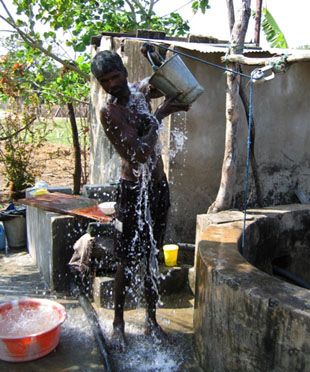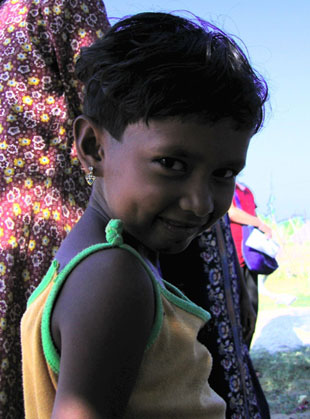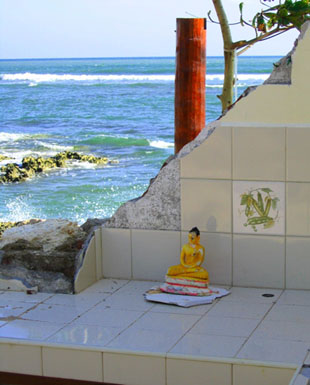COLOMBO – Today is the 3rd of March, 2005; the sound of traffic, the megaphone-amplified voices of lottery hawkers, and the hotel room’s air conditioning provide a familiar background to my last morning in Colombo. Across Galle Face Road lies the sea, but the white noise of the waves never seems to reach my room. I often wonder what sounds I might have heard here 100 years ago, before automobiles became the dominant species on the planet.
It’s been two months, exactly, since I left the USA for what was meant to be 2-3 week tour, and Sri Lanka is starting to feel a bit like Gilligan’s Island. Now a ship is on the horizon — a Boeing 777, actually — and unless I hail it down I could end up being marooned in this world for a very long time to come.
Three time-worn clichés ring through my mind on my final day here in Sri Lanka. The first: “A disaster brings out the best and the worst in people.” The second: “The more you know, the more you realize you don’t know.” The third isn’t really a cliché, but it’s a familiar line among Monty Python fans: “No one expects the Spanish Inquisition.”
Two months isn’t a long time, but it’s long enough to see examples of nearly everything that attends a monumental natural disaster. There have been plenty of examples in the dispatches; from weeping fishermen in Arugam Bay to the monk who floated to safety in an inner tube; from children’s shoes in stagnant puddles to the gleeful distribution of Frisbees and volleyballs in refugee camps.

Stories like those are easy to convey; they’re neatly packaged, and visceral. They have a beginning and an end. But the relief process, I’ve learned, is far more amorphous. For one thing, it’s ongoing: a continuous learning curve for the organizations as well as the victims of the tsunami. But it’s not a linear process. There’s progress, and there are reversals. And there’s often a huge gray area between our high-minded goals and what we actually end up achieving.
When I first thought about writing a final dispatch I imagined that I could sum up the situation here in a neat package. Every day, though, the information changes. What one reports depends entirely on what conversations one hears, the articles one reads, the direction one’s attention is focused at any given moment. During the past 24 hours alone, for example, I’ve heard that:
- The number of donated fishing canoes now exceeds, by 4,000, the number of canoes damaged by the tsunami;
- Thirty-seven generators intended for tsunami relief were stolen by an official in Trincomalee;
- Fishermen on the southeast coast have been drilling holes in undamaged boats, applying for USAID repair kids, then plugging the drilled holes and selling the kits;
- While refugees relocated as a result of Sri Lanka’s 20-year civil war receive 300 rupees a month in government compensation (about $3), refugees displaced by the tsunami are getting Rs. 325 a week – creating a situation that could eventually erupt into violence;
- The government’s directive that no houses can be rebuilt within 100 meters of the high tide line continues to paralyze local reconstruction efforts;
- Many fishermen are reluctant to accept clean-up assistance, fearing that government inspectors will accuse them of falsifying damage reports;
- An estimated 20% of the tsunami victims have still received no long-term assistance other than food, tents, and basic medical care.

But those details don’t tell the whole story. All over the island, successful relief and rehabilitation efforts are meeting with success. Mercy Corps is funding dozens of such projects, and I’ve spent the past 10 days writing them up for in-house use. They include cash-for-labor programs, play therapy for kids, money to kick-start small businesses, and the cleaning of hundreds of village wells.
And though it may not seem evident from the horror stories, people are indeed rebuilding their homes, and their lives. Children are back in school, hotels are re-opening (although the majority of their clients are relief workers), and the fishing industry is coming back on line. Refugees are leaving some of the camps and returning to their villages, ready to pick up the pieces and move on.
* * *
Where’s it all leading? I don’t know. Things could go anywhere from here.
Much depends on whether the government and Tamil Tigers (LTTE) use the disaster as an opportunity for peacemaking, or primate posturing. The ceasefire, brokered only two years ago, was in a pretty fragile state when the tsunami struck. Since January, both sides have used the relief effort as a springboard for political gymnastics. This conflict will die hard – and there are plenty of people who have investments in seeing the strife continue, lest their own position become obsolete. In spite of this, though, amazing efforts at reconciliation have been made by individuals on both sides of the ethnic divide – and by Muslims and Christians as well.
Another big issue is, simply, greed. The amount of money that has poured into this country is almost obscene, orders of magnitude beyond what was expected. As one high-level aid worker aptly put it, “These guys are realizing they’ve just won the lottery.”
It’s true. I don’t know the exact figure, but there is easily enough money floating to give every person who suffered losses in the tsunami a personal check for at least 150,000 rupees – the equivalent of a full year’s earnings. Not a few relief workers feel this would have been a far more sensible solution than the chaotic, top-down efforts now underway. Such a distribution won’t happen, of course; the NGOs want to stay in business, as do the international relief agencies. Meanwhile, members of Sri Lanka’s government – the conduit for all this cash -are set to make out like thieves.

No wonder that, amid the clouds of confusion, government ministers are focused on the silver lining. There’s a gleeful anticipation in the air; the giddy understanding that Sri Lanka can suddenly ask for, and get, anything it desires. Entire industries can be rebuilt to a higher standard. Thousands of acres of farmland and coastline can be declared “impacted,” and made eligible for aid grants. The tourism infrastructure can be revamped, building contracts handed over to old friends, new roads and bridges commissioned. The scramble is on, and the eggs are golden.
But now… Stop Press!… I’ve just heard a report, literally between paragraphs, that there were demonstrations in the northeastern coastal city of Trincomalee today. The unrest was stemmed from a conflict between Sinhalese and Tamils, infuriated by the unequal distribution of relief. There’s a curfew in Trinco this evening, and tomorrow there will be a hartal, or work stoppage, called by the LTTE.
So the concerns listed above may soon be moot. The Sri Lankan government, an expatriate economist confides, is unlikely to make it through April. Hmmm. Seems like I picked an awkward time to leave. As you may well imagine, the edgier the news gets, the more I’ll wish I’d stuck around.
Still, it’s time to go home, at least for a while, and water my plants. Two months is just long enough to stay interested – and interesting. Beyond that there’s the danger of what I call the “Kathmandu Syndrome,” identified during my years among writers in Nepal. It’s the delusional belief that everyone on earth is ardently awaiting news of your global backwater, long after it has vanished from the pages of the Times.
And so, after taking a final stroll along the Galle Face Walk, eating chips from a hand-made paper sack, I’ll take the long drive up Negombo Road to the airport and begin the three-leg, 24-hour journey back to Oakland, California.
But I may well return. As it happens, one of the most interesting things I’ve done in Sri Lanka isn’t written up in my stories. On several occasions, during visits to refugee camps and relief centers, I’ve taped video interviews with tsunami survivors. With the help of local translators, refugees of all ages, genders and ethnic backgrounds have sat for the camera. and told me how they survived the waves. They’ve discussed their current conditions, and shared their hopes for the future.

It’ll be fascinating to come back to Sri Lanka early next year, and follow-up with these individuals. That, more than any amount of speculation, will show me how the recovery process has gone, and if these vast and expensive relief efforts have succeeded.
* * *
And so I conclude this journal, and this journey – and what a long, strange trip it’s been. I’d like to thank all of you who have read these ten dispatches, whether on Salon, Ethical Traveler, Things Asian, or Islands. A sincere thanks to those who have responded; I’ve been especially honored to receive letters from Sri Lankan nationals, living at home and abroad, who found in these stories a fresh perspective on the events unfolding in their country.
As for me, these eight weeks with Mercy Corps have been a cram course in the realities of international relief work, which is not always a tidy dossier of well-laid plans with happy endings. My colleagues here in Sri Lanka, some of whom have been doing this in dozens of countries for decades, were tickled to death by my initial idealism – but it wasn’t a bad thing to remind them of where they, too, started.
“I’ve long ago given up any notion of saving the world,” confessed a Mercy Corps consultant, who has worked everywhere from Kosovo to Uganda. “But I guess I must keep a seed of it alive – otherwise, I’d never get on the plane.”
And I must believe there’s something of equal or greater value waiting for me back home, or I’d never board mine.
We’ll see what comes next; I have faith it will be equally fascinating. This is, after all, planet Earth. There’s no lack of material.
Read Ethical Traveler's Reprint Policy.
